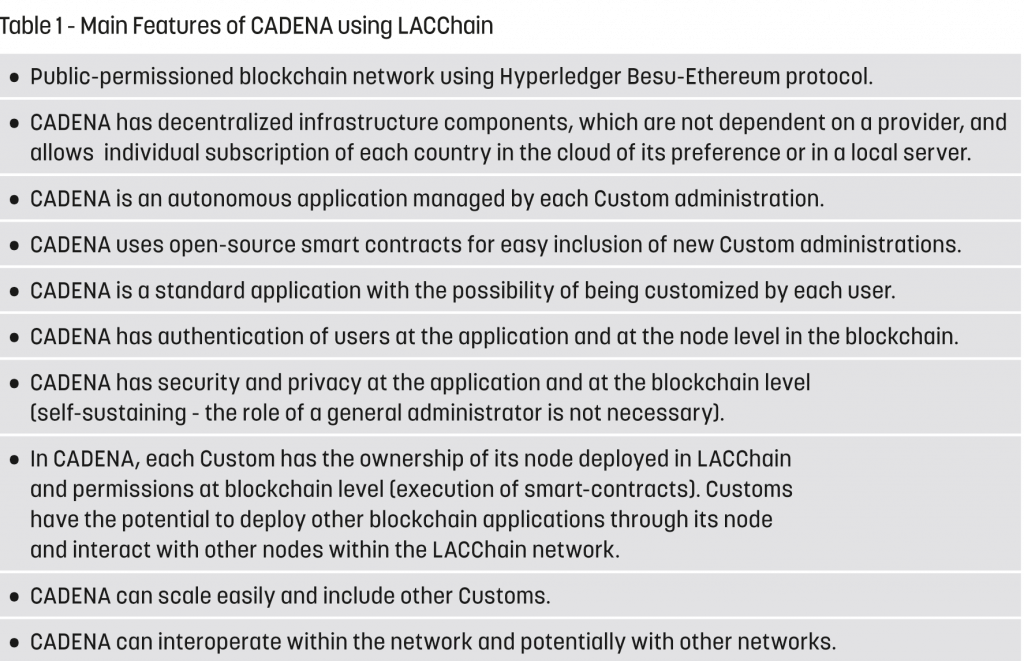Improving data sharing with blockchain
1 March 2021
By Sandra Corcuera Santamaría, Michelle Moreno, and Marcos Allende, Inter-American Development Bank and LACChainTowards a digital transformation
COVID-19 has put immense pressure on traders and supply-chain managers and has highlighted the need for more traceability and visibility in trade transactions, and for more interoperability in IT systems, including those of logistics providers. Progress in these areas will be crucial to enhance Customs operations. Customs itself has learned a number of important lessons, and the crisis has boosted its digital transformation processes and the adoption of new technologies.
This article provides an update on a project launched to enable the automatic exchange of information on Authorized Economic Operators (AEO) between Customs administrations which have entered into a Mutual Recognition Agreement (MRA). Since 2018, with the support of the Inter-American Development Bank (IDB)[1], AEO programme officers and information technology (IT) specialists from Colombia, Chile, Costa Rica, Mexico, and Peru Customs have been developing an application[2] called Cadena, designed specifically to improve the exchange of information between Customs.
CADENA was design as a blockchain-based solution, to leverage the clear advantages that this technology offers for the management of the AEO certificates under the implementation of MRAs. CADENA enables to record and share information between a group of Custom administrations according to an agreed protocol, with each exchange of data being secured and protected by a secure channel and an immutable audit trail in a blockchain network. For the IT specialists, this represented a unique opportunity to learn about the implementation and use of the technology.
As the project has now reached maturity, with three more Customs administrations (Bolivia, Ecuador, and Guatemala) joining at the beginning of 2021, it is a good time to share the lessons learned during the process with the wider Customs community.
How it works
As soon as a company AEO certification is approved, a Customs officer in country A uploads information on that company to CADENA. The application automatically sends a notification to inform Customs in country B, with which Customs in country A has signed an MRA. Customs officers from country B can access the data related to this new AEO through CADENA. Alternatively, CADENA can be automatically populated via APIs[3] with data from an AEO certification module in an automated Customs management system or an Electronic Single Window. The application could also interact directly with the Customs risk management system in country B via APIs. As the system has been instructed to consider AEOs to represent a low risk in terms of security and fraud, the company would immediately benefit from a lower level of inspection. Any change in the status of the AEO will be also notified through the same path.
CADENA greatly facilitates the operational implementation of MRAs by ensuring that a company’s certification, as well as the suspension and cancellation of this status, are registered in real time and shared with all Customs administrations which are signatories to an MRA. The administrations with access to CADENA now have a digitalized, automated, secured, and reliable mechanism for sharing information on AEO certificates. Data integrity is optimized as access to the data is protected and managed by granting different roles and permissions to users[4].
Learning throughout the process
According to ISO, there are three different types of blockchain networks: public permissionless, public permissioned, and private permissioned. This taxonomy refers to who has the ability to be a user of, or run a node on the blockchain (a node is a computer that shares a copy of the blockchain and is synchronized with the others). Each type of blockchain places a different level of importance on anonymity, immutability, efficiency, and transparency.
CADENA was implemented in two phases and has evolved over time as blockchain technology has progressed. The first version of CADENA was built on top of a private permissioned blockchain during the first year of its implementation, from 2018 to 2019, proving to be successful in allowing the real-time exchange of data between Customs. However, some challenges were soon identified. These revolved mainly around some of the limitations of the technological infrastructure, which required Customs to be responsible for its maintenance, including technical troubleshooting, onboarding of new entities, and financial sustainability. This had a high impact on the governance, maintenance, data privacy, sustainability, and further scalability of CADENA.
Realizing the limitations that CADENA and other IDB projects were facing, in 2018 the IDB Lab launched LACChain, the Global Alliance for the development of the blockchain ecosystem in Latin America and the Caribbean. LACChain developed a public permissioned blockchain infrastructure using Hyperledger Besu (an Ethereum client) that is compatible with other similar initiatives such as the European Blockchain Service Infrastructure (EBSI) developed by the European Commission, and ALASTRIA in Spain. The LACChain blockchain network is provided by the IDB Lab and its partners (both public and private) as a public good for Latin America and the Caribbean. The LACChain team guarantees the governance, maintenance, data privacy, sustainability, and scalability of the network, and that entities using it can benefit from a reliable infrastructure on top of which they can develop any blockchain solution.
This was ideal for CADENA, and, in 2019, entering the second phase, the CADENA team opted to use LACChain as the technological infrastructure. Custom administrations found in LACChain optimal autonomy and a sustainable infrastructure, as well as capabilities for further scalability to other users, and interoperability with other solutions and applications which might opt to be deployed on the LACChain network. LACChain main features are its openness, publicness and decentralized nature. It is also low cost for the user because it is not based on transactions fees. It is not anonymous, not based on the use of cryptocurrencies and bonded to laws and regulations. Table 1 shows some of the main features provided by LACChain to CADENA.

Each Customs administration deploying the CADENA application has ownership of its node, in other words its own access point to the LACChain blockchain network. Permissions exist at the node and LACChain level (execution of smart contracts). Every time a Customs administration generates information to be exchanged with other Customs administrations through CADENA, the application connects to the LACChain platform and calls up a smart contract that contains the logic showing which Customs administrations need to receive the information. The data is then exchanged over a private and secure sidechain, and the cryptographic proofs are registered in the LACChain public ledger. This enables data to be processed without overloading CADENA. Customs therefore has a more secure real-time solution for the exchange of information, and an immutable ledger that guarantees the integrity of the data.
LACChain also offers Customs the possibility of deploying other blockchain applications and connecting them with all of the applications developed by public or private entities also using the regional network.
Lessons learned
Customs administrations and other public and private entities which have a role in securing and facilitating the supply chain and are considering the use of blockchain can learn valuable lessons from the CADENA project. In addition to the importance of using a technological infrastructure that facilitates simpler governance and maintenance, allows the implementation of regulatory frameworks, and addresses data privacy and user authentication, the project has shown how important it is to:
- use international standards such as the WCO Data Model and the WCO Trader Identification Number (TIN) when developing all of the data sets to be exchanged;
- use international standards such as W3C Decentralized Identifiers to develop a digital identity for users;
- build onto national regulations, processes, and international guidelines;
- narrow the proof of concept (PoC) to a specific challenge that requires multi-stakeholder interactions to test and validate the solution, and only then add other functionalities and participants. In other words, start small;
- adopt an inclusive co-creation process in which specialists from the business, technical and even legal areas participate to guarantee regulatory alignment, functionality of the processes and the technological viability of the solution;
- consider the proof-of-concept phase as a learning process and opportunity to develop knowledge about the potential of blockchain technology with a view to scalability down the road;
- remain engaged in the global technical discussions, contribute and be generous. The overall success of the technology depends on the level of adoption by others and on not making the same mistakes;
- iterate and establish milestones for functional and integration tests while implementing the proof of concept to identify areas for improvement;
- opt for open-source solutions and document them in shared repositories (Githubs);
- be willing to be flexible and take some risk during the proof-of-concept phase. Technical solutions and services which are not foreseen at the beginning of the project should be incorporated during the development phase as and when they become available;
- develop a strategy to validate the cybersecurity of the application and its components.
Way ahead
CADENA has also been built with the capacity for other government entities and even the private sector to access specific data following a process of authorization and authentication. This opens up the possibility to develop further functionalities within the application. CADENA can also be integrated with legacy Customs systems and with other IT systems through an API.
At the same time, other applications embedded in different infrastructures and blockchain networks are being developed, such as B-Connect (another solution for the exchange of AEO data developed by MERCOSUR countries) and the European Blockchain Service Infrastructure. Accordingly, ensuring interoperability will once more be at the heart of the future developments of CADENA and LACChain.
More information
https://www.iadb.org/en
sandracs@iadb.org
michellem@iadb.org
marcosal@iadb.org
[1] https://blogs.iadb.org/integration-trade/en/blockchain-trade-safer/
[2] https://publications.iadb.org/es/revista-integracion-comercio-ano-24-no-46-diciembre-2020-blockchain-y-comercio-internacional-nuevas-tecnologias and https://mag.wcoomd.org/magazine/wco-news-87/cadena-a-blockchain-enabled-solution-for-the-implementation-of-mutual-recognition-arrangements-agreements/
[3] Tools that specify ways in which software can interact with an application such that the data from the latter is available in the former. APIs interact with the target application exclusively through the back end.
[4] W3C Decentralized Identifiers https://w3c-ccg.github.io/did-spec/; W3C Verifiable Credentials Data Model https://www.w3.org/TR/verifiable-claims-data-model/ ; The Decentralized Key Management System (DKMS) https://github.com/WebOfTrustInfo/rwot4-paris/blob/master/topics-and-advance-readings/dkms-decentralized-key-mgmt-system.md
Michelle Moreno is Senior IT Specialist at the IDB, Sandra Corcuera Santamaria a Senior Trade Specialist at the IDB, and Marcos Allende an IT Specialist at the IDB and Technical Leader of LACChain

